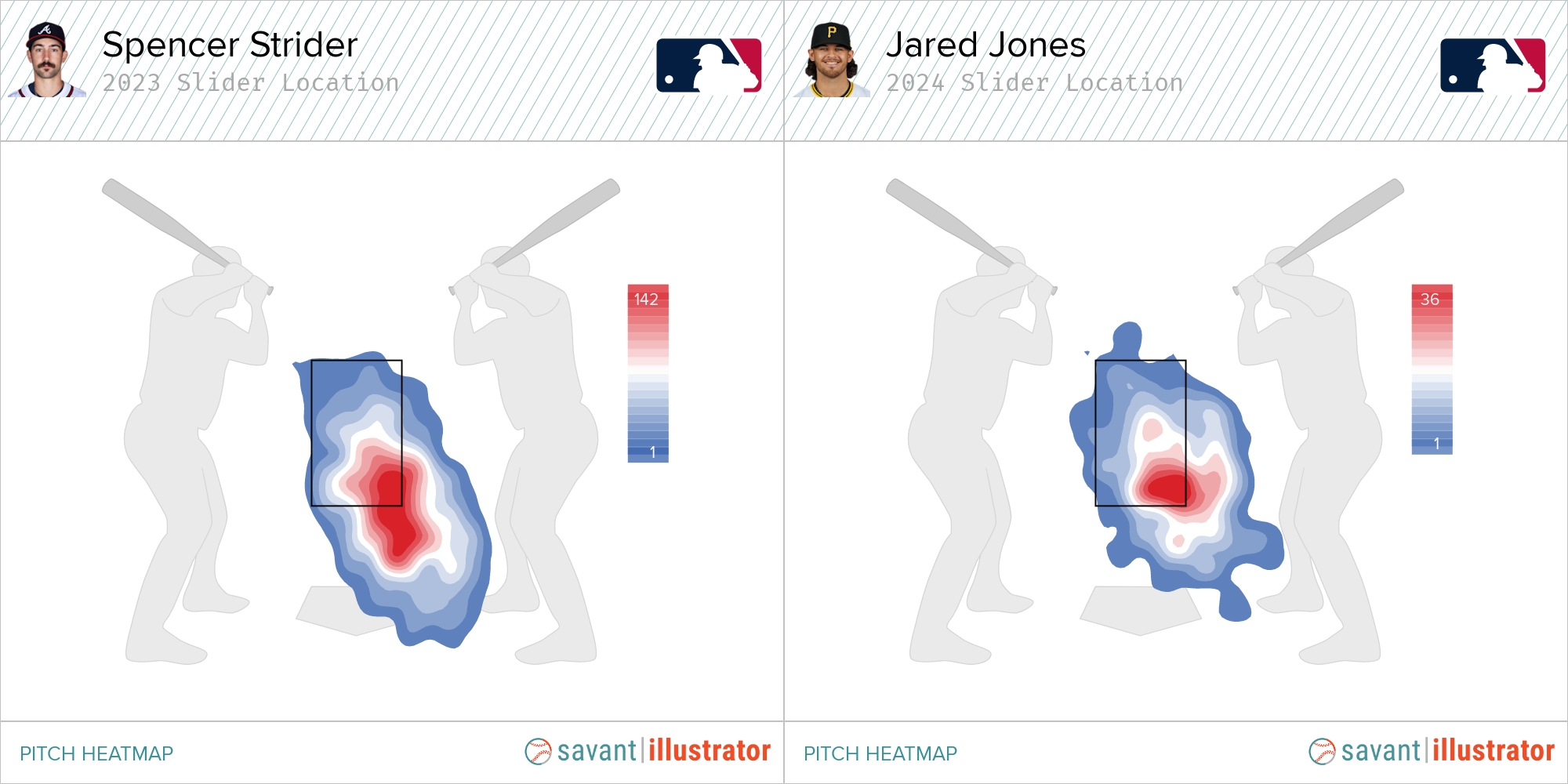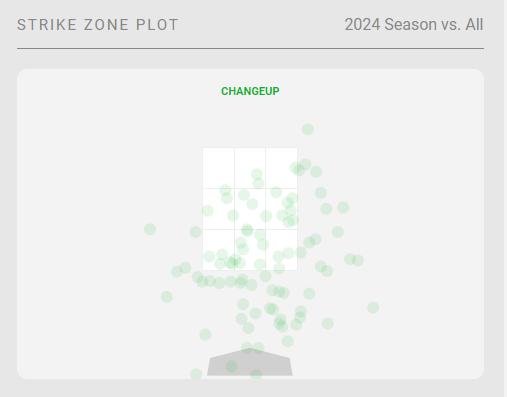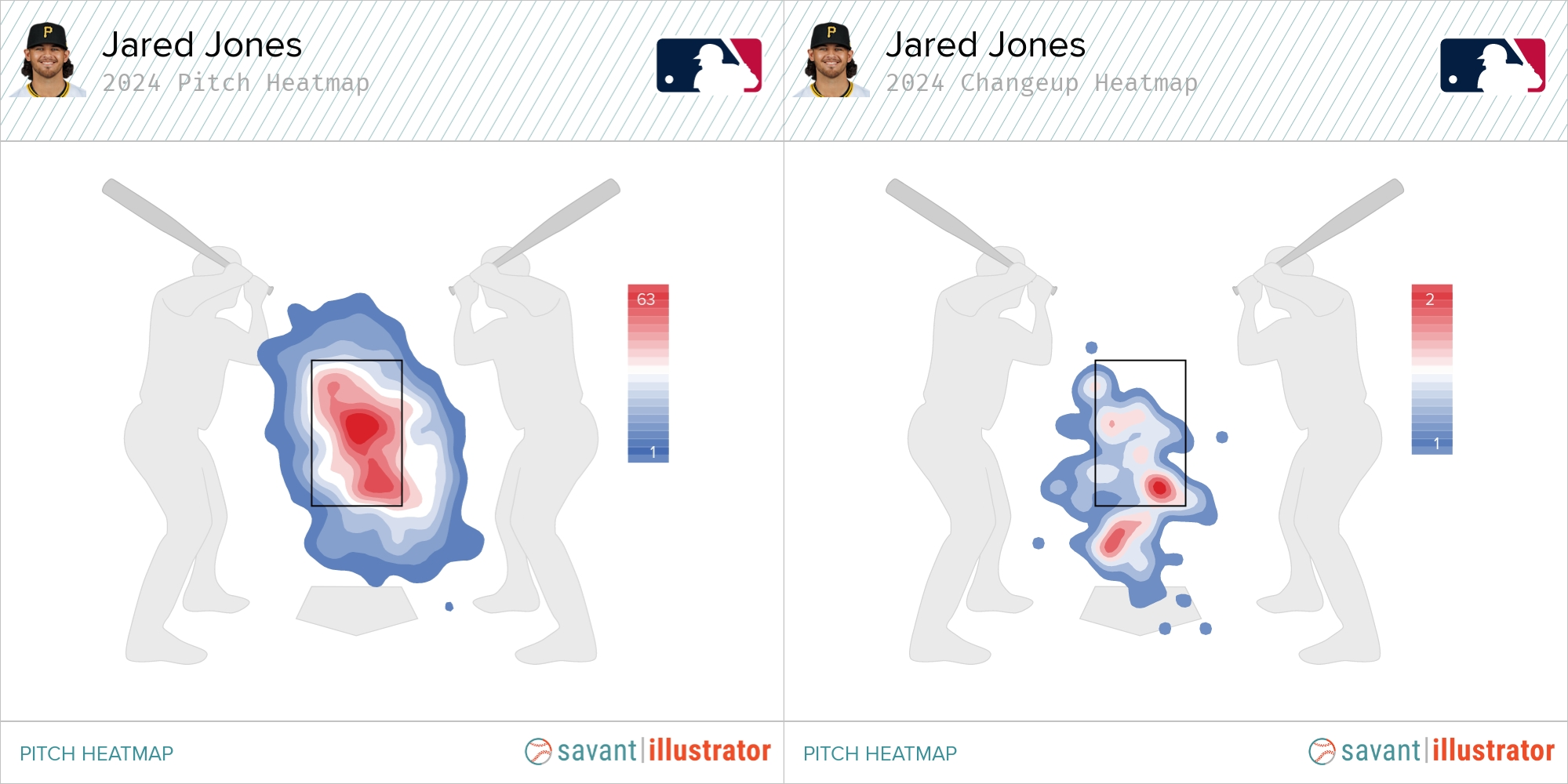It’s almost never a bad thing to be closely associated with Spencer Strider.
But right now, Jared Jones has a Spencer Strider problem. Two of baseball’s most electric arms (when healthy) are eerily similar, giving them some of the same strengths and weaknesses.
They use an elite fastball/slider combination over 80% of the time, leading to trouble for the third time through the order and related home run problems. No matter how filthy the combo is, it’s hard to beat hitters a third time. I wrote about Spencer Strider’s changeup in the spring, citing the need for increased usage of a pitch in a different part of the strike zone. Though we didn’t get to see that pan out this year (and we did get a hint at a new curveball), Jones almost perfectly replaced Strider as a pitcher who needs to address this problem. Like Strider, Jones is right there but needs to refine his third and fourth pitches.
Have We Ever Seen Spencer Strider and Jared Jones in the Same Room?
They may be the same pitcher if you ignore that they both pitched on April 5th of this year.
Sure, there are some slight differences, but they have nearly identical extension and induced vertical break (iVB) on their fastballs. Jones’s fastball is actually a bit better, coming in 1 mph harder on average from a lower release height.
Their fastball usage by count and location are almost indistinguishable too:
This compares Jones’s 2024 with Strider’s 2023, and their vertical locations are identical. Though both are in the 75th percentile for iVB, they elevate their fastballs at a below-average rate. This comes from the fastball usage, as they need to diversify locations for a pitch used around half of the time. Their fastball results are nearly identical, too. They have the same elite whiff rate (29%), similar zone contact rates around 74%, and similar 40% ideal contact rates (ICR).
As for their sliders, the two pitchers part ways on movement: Jones throws his slider 3 mph harder with almost 2 inches less sweep and around an inch less drop. Regardless, they use them in comparable counts, and their heatmaps look excellent, budding off the gloveside corner down and away. Jones throws his slider 54% of the time early and 38% in two-strike counts, compared to Strider’s 55% early and 40% in two-strike counts.

From a results perspective, Strider gets his out of the zone more, due to less velocity and more drop, resulting in more whiffs. “More whiffs” is on a scale from absurd to otherworldly, as Strider’s slider in 2023 had a 55.3% whiff rate compared to Jones’s 38.7%.
For at least 85% of their pitches, these two are more or less the same, performing at ace levels. The other 15% holds them back.
Maximizing the 15% and Earning Longevity
For pitchers, longevity doesn’t just happen. Some days, batted balls find gloves, no matter how hard they’re hit, and you realize you’re in the 7th at 75 pitches. But those are the rare nights. The Scherzers, Kershaws, or Verlanders of the world (or what’s left of them) find another gear that hitters just don’t expect when they step into the batter’s box for the third time. The true aces have the tools to overpower and confuse hitters no matter how many times they see each other, whether it’s the fourth pitch of an at-bat or the hundredth of a career-long battle.
For the next generation of aces like Strider and Jones, who are equipped with arguably better stuff than we’ve ever seen, they need to earn that longevity. The wipeout two-pitch combo is rare among starters for one key reason: the times through the order penalty (TTOP). In 2020, Ethan Moore at Prospects365 found that there’s more evidence of TTOP being attributed to hitters adjusting to pitchers each plate appearance instead of the result of fatigue. With only two primary pitches, it’s easier to adjust to limited options compared to a kitchen sink pitcher with four or more pitches.
Hence why Strider added the curveball this year: it was set to be the last tool needed to turn him into a bonafide ace. Though injury took down Strider before we got a legitimate sample of the curveball, the proof-of-concept suggests Jones needs an actual other option. It’s a pitch Strider used just 12% of the time (albeit in two starts), but those percentages play up if used primarily later in games.
Additionally, like Strider, Jones has exhibited days where one pitch isn’t working. Against the Tigers on May 29th, the fastball fell flat and went 0/31 whiffs, resulting in 46% slider usage. Hitters can sit on one pitch, crush mistakes, and leave Jones hanging his head after five earned runs.
So, we’ve gotten this far, and I haven’t actually explained what Jones’s last 15% is. He has a changeup and curveball that he uses equally but they take to different sides of the same coin in underwhelming results. The changeup has a respectable 15.6% swinging strike rate but a meager 5.6% called strike rate, along with 48.0% ICR (21st percentile). Conversely, the curveball has a low 8.2% swinging strike rate and an exceptional 31.8% called strike rate, with a strong 33.3% ICR (71st percentile). However, the curveball has a poor .772 xSLG.
Though both pitches have promise, Jones’s usage needs to be re-aligned to match his position in the game. He doesn’t dramatically alter his pitch mix later in games, which arguably makes him more predictable.
The only time a non-fastball or slider has over 10% usage is the changeup, both 2nd and 3rd TTO to lefties. In those instances, the changeup is thrown 43% in 0-1, 1-1, 1-0 counts and 19% in 0-0 counts. That’s Jones relying on the changeup to steal a called strike more often than he should. The changeup fails to consistently get called strikes and gets mashed when thrown in the zone in these situations (which we’ll get to later).
Meanwhile, the curveball, which is basically only thrown early in the count, does a much better job of getting called strikes. Lefties have only swung at 23% of them, successfully progressing Jones later into the at-bat. The curveball, like the changeup, also gets mashed in these situations but at a lesser frequency.
Jones needs to backload pitch usage both in terms of TTO and within at-bats. His minimal deviation from normal usage makes him predictable and hitters have seen him many times, making it easy to take advantage. The pure TTO splits are clear as day:
The ERA difference doesn’t come from a change in strikeouts or walks but rather the quality of contact that he gives up. Even small tweaks can turn Jones into a dominant 7+ inning starter. He’s in the 77th percentile for pitches per inning (lower being better) among qualified starters at 15.4 pitches per inning, so efficiency isn’t the issue.
Tweaking the Secondary Pitches
This is where the development of young pitchers gets blurred from the public side. Usage changes are relatively easy to perform if the team recognizes a change needs to be made. As for mechanical/stuff changes, it’s very difficult to know if a player is capable of making an in-season change. Jones has previously talked about making a grip change in Spring Training, but in-season changes on a team that’s in the Wild Card hunt (thanks, National League) can be tough. So, while I can talk about some changes, these may be developments that won’t happen until 2025.
Between his changeup and curveball, I believe the changeup should be the pitch that gets attention for improvement. The curveball is doing its job as a called strike pitch early in counts, and putting developmental effort into the curveball may be unnecessary if it won’t be used in more meaningful counts.
The changeup lacks the deception required to get called strikes, and that’s likely because there are substantial differences in the release. Compared to the fastball, Jones gets three inches less extension and releases the pitch two inches higher on average. The consistent difference between the two can take away from the changeup’s effectiveness, according to a Fangraphs article from 2015. Additionally, that much of a deviation from his primary release could cause problems with repeatability.
When located down-and-armside, the changeup shows its promise: it has a 45.1% chase rate (88th percentile) and a 56.5% o-contact rate (65th percentile).
The pitch grades out really well, hence why it does well in whiff locations. It has a 122 Stuff+, the fourth-highest among qualified starter changeups, trailing Grayson Rodriguez, Logan Webb, and Ronel Blanco. However, it’s the lack of deception, which isn’t quantified in a stuff model, that makes it struggle in the zone. The changeup has a 43.3% zone rate (80th percentile), 88.2% zone-contact rate (31st percentile), and 48.0% ICR (21st percentile). Lots of strikes, not a lot of in-zone whiffs, and a lot of hard contact.
Looking at the pitch locations, it seems he can easily get the changeup below the zone, but doesn’t have great command in the zone. This explains part of the discrepancy in results between in-zone and out-of-zone. It also doesn’t help that he’s thrown a lot of changeups in the lower-inner quadrant of the zone to lefties, which is their nitro zone.

One example of poor location is this 0-1 changeup to Jake Cave. With two outs and a career 86 wRC+ hitter at the plate, Jones grooves a changeup over the heart of the plate, resulting in a 2-run double.
The catcher seemingly holds the glove middle-middle before appearing to set up for the changeup away. By using more accurate targets, the catcher’s setup could be a potential place to improve to help Jones locate in the zone better. Other than that, Jones should at least toy around with a changeup release that’s closer extension-wise to his fastball. The changeup whiffs are nice, but he would greatly benefit from more deception that can get him much-needed called strikes.
If Jones can successfully develop a consistent third pitch, one that can get whiffs and called strikes, it would likely make him a complete pitcher. Add in additional usage changes, and now he knows he has a tool to consistently get to the down-and-armside, his most infrequent spot.

Pittsburgh Needs Jones to Take Another Step Forward
I spent the better part of 1700 words talking about changes Jones needs to make. For a 22-year-old who’s proving his worth in the big leagues right now, if it ain’t broke, why fix it?
The pitcher-hitter matchup will always be a cat-and-mouse game. If Jones can stay on the forefront of adjusting, he can stay one step ahead. Many rookies dominate early and then struggle to recover once the book is out on them (looking at you, Reid Detmers).
It’s also a big test for the Pittsburgh Pirates themselves, having lately struggled with aspects to player development. They find themselves in possession of two ace-like arms in Paul Skenes and Jones: two guys who look like they could anchor a playoff rotation with ease in the near future. We’ve seen Skenes add the splinker in an offseason, and it comes down to if Jones can make the necessary changes to put him a tier above where he is now.
The recent past of the Pirates has been painful for their fans. Whether it’s the 98-win team in 2015 that got brutally relegated to the Wild Card game or even last year’s scorching 20-8 start to the year, Pirate fandom can be summarized in the phrase, “It’s the hope that kills you.” They now have the most coveted asset in baseball: good team-controlled young pitching. The opportunity to overcome the misfortune of the last decade is right there, and I know enough Pirates fans who deserve to watch their two future aces pitch in meaningful October baseball.
All data as of Friday, June 22.

Amazing article. Thanks for sharing
Great article, I really enjoyed it. I have Jones this year, but I’ll be carefully watching the reports from spring training next year to see if he’s going to take another step forward and be worth the certainly increased price.